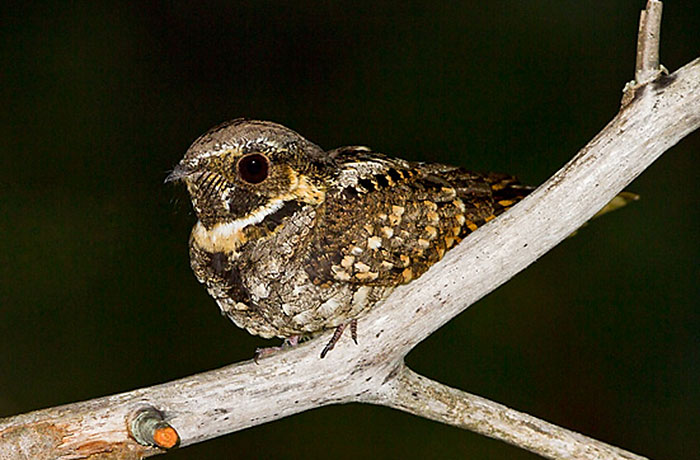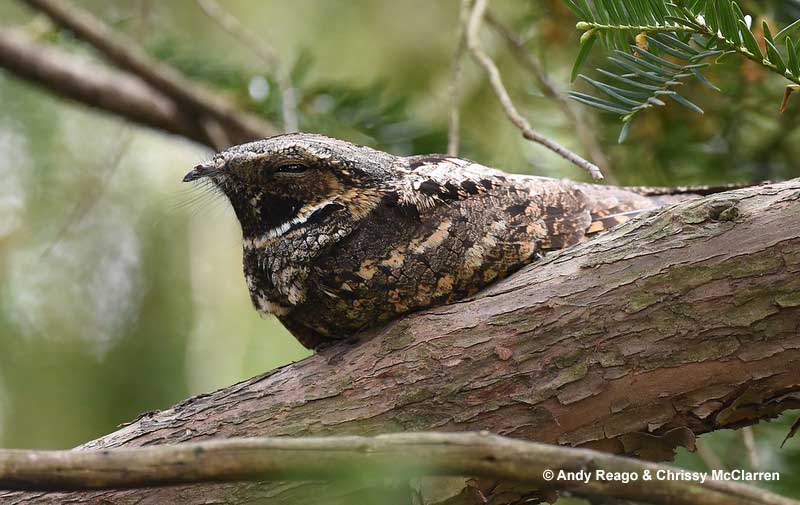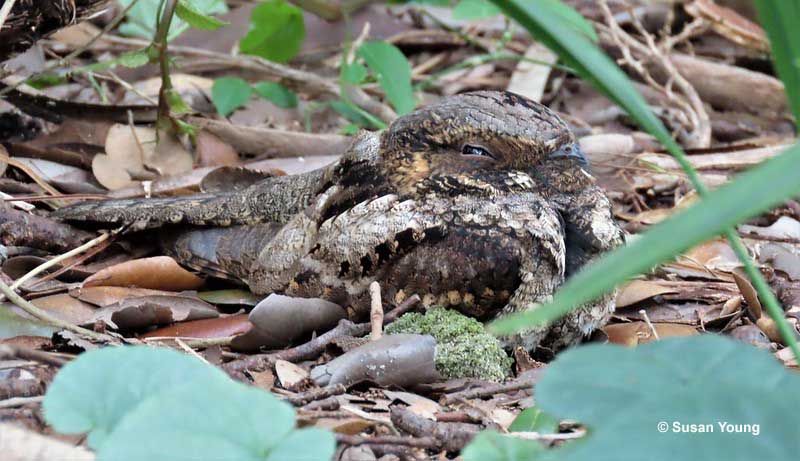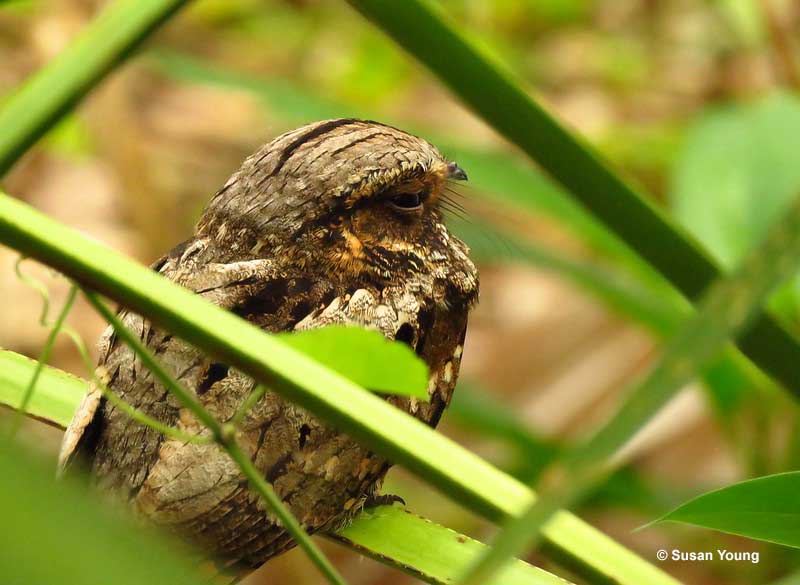The Eastern Whip-poor-will (Antrostomus vociferus) is a fairly small, mottled gray and brown nightbird with a dark stripe on its crown and a narrow white mark on its throat.
This nightjar is an uncommon and local bird in forests and woodlands with open understories. Listen for this bird calling its name in spring and on warm summer nights.
Have you wondered what Whip-poor-wills do?
On this page
Identification
Male
The male Eastern Whip-poor-will is a fluffy, robin-sized nightjar with mottled brown and gray plumage. It has a rather large head with a prominent, thick black stripe on its grayish crown, red-brown on its face, and big dark eyes.
This nightjar also has a dark throat, a hint of a pale mustache mark, and often has a narrow white “necklace” on its throat. This bird’s upperparts are mottled gray and brown with some black markings, and its wings have pale gray shoulders edged with black spots.
Male Eastern Whip-poor-wills also have big white corners on their black and brown tail.
Female
The female Eastern Whip-poor-will looks almost exactly like her male counterpart. Both sexes are 9.75 inches long, have a 19-inch wingspan, and weigh 1.9 ounces. Like the male, female Eastern Whip-poor-wills also have long red-brown and gray wings with rounded tips.
Similar to males, they also have indistinct barring on their gray or red-brown underparts, and have buff colors on their belly and undertail. The main way to separate the female from the male is by her tail pattern.
Female Eastern Whip-poor-will tails lack bold white spots on black feathers. Instead, they have small buff-colored corners on their mottled brown tails.
Vocalizations
Male Eastern Whip-poor-wills make a whistled, unforgettable vocalization that sounds like their name, “whip-poor-will!”. They rapidly sing this over and over, often for several minutes at a time. Whip-poor-wills only sing at night and mostly in spring and early summer.
Related: Why do birds chirp at night?
Both sexes also make a brief, liquid sounding call, “wik…wik”. They usually make this vocalization at dusk and dawn. They can also make other growling, clucking, and even hissing sounds.
Food
Eastern Whip-poor-wills feed on flying insects. They occasionally forage in rotting logs for caterpillars and ants but catch the majority of their food in flight.
These nocturnal birds eat a lot of moths and may prefer larger ones like Luna Moths and other big silk moths. However, they also catch other insects including grasshoppers, flying ants, beetles, and other species.
This species catches its insect prey by flying into the air and snatching the moth or bug with its big mouth. They usually sally from a tree or other perch but can also fly up from gravel roads and other open spots.
Eastern Whip-poor-wills do most of their foraging at dusk, dawn, and on moonlit nights. They won’t do any foraging on dark, rainy nights. In all likelihood, their foraging behavior is related to using their vision to see and catch insects.
This is probably why their prefer to forage in open spots where they can look up and see the sky. That way, if a bug flies overhead, they can see the silhouette and catch it. Eastern Whip-poor-wills might also catch insects during extended flights through open areas. They also hit foliage with their wings to catch bugs scared out of hiding.
Nesting and Eggs
Eastern Whip-poor-wills come back on their breeding grounds in April and form pairs within two weeks of arrival. At the northern limit of their range, they might return to their breeding grounds until mid-May.
Instead of building a nest, female Eastern Whip-poor-wills lay two eggs on the forest floor. She can also lay eggs on bare ground or rotting logs but usually picks a spot with leaf litter. The mother bird also picks a spot under the northern side of a sapling or shrub.
She does this to help the eggs and protect them from direct sunlight. The eggs are 1.2 inches long, and are cream-colored with some lavender and red-brown markings.
After three weeks of incubation by both parents, they hatch and two cute, fuzzy, orange baby birds emerge.
Both parents are then kept busy feeding the babies. They regurgitate food directly into their mouths and can still feed their young when the babies are 30 days old. On average, the young Eastern Whip-poor-wills can fly at 20 days of age and also start foraging or themselves around that time.
No one knows when the fledgling Eastern Whip-poor-wills leave their parents. However, some young birds have been seen with their parents until just before fall migration.
Current Situation
The Eastern Whip-poor-will is an uncommon breeding species in woodland habitats in parts of central and southeastern Canada, and many parts of the eastern USA south to Georgia and Arkansas. In fall, they migrate to woodlands and second growth from coastal North Carolina to Florida and coastal areas west to Texas. They also winter south to Central America.
This species is listed as Near Threatened in the IUCN Red List and has become uncommon in many parts of its range.
The formerly common Eastern Whip-poor-will has greatly declined in many areas. The exact reasons for their decline aren’t known but are thought to be related to various factors. They have probably been affected by various types of habitat degradation, and forests becoming too dense for nesting and good feeding opportunities.
These birds are completely dependent on flying insects, especially large moths. As pesticides and other factors kill off these insects, there is much less food available for Eastern Whip-poor-wills.
Facts
- Eastern Whip-poor-wills have night vision. They have a reflective structure behind their retinas that helps them see better in the dark.
- This species is very much reliant on moonlight to catch more insects. For this reason, they coincide egg laying with the lunar cycle. They usually lay their eggs ten days before a full moon so they can catch more insects when their babies hatch.
- If you are walking in the woods and an Eastern Whip-poor-will suddenly hovers near you, there’s probably a nest nearby. When people or animals get too close to their nest, male Eastern Whip-poor-wills try to distract the potential threat by hovering near the intruder and spreading their tail to show its big white spots.
- This species has been mentioned in many stories and early works of American fiction. A few of the authors who have included the Whip-poor-will in their stories and poems are Emily Dickinson, H.P. Lovecraft, and Washington Irving in “The Legend of Sleepy Hollow”.
- The Eastern Whip-poor-will used to be considered the same species as the whip-poor-wills in the southwestern USA. However, DNA studies and song differences have shown that they are indeed separate species.
Similar Species
The Eastern Whip-poor-will has a distinctive song. However, its plumage can be easily confused with a few other species.
Chuck-will’s-widow
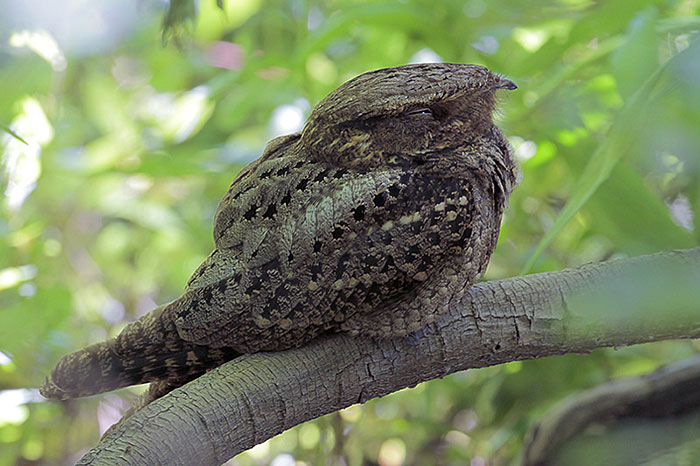
The related Chuck-will’s-widow has pretty similar, mottled brown and gray plumage. However, it is a bigger bird and has a larger head with fine, dark streaks on its crown. The Chuck-will’s-widow also lacks big, black and white tail spots, and the white shown on the throat of the Eastern Whip-poor-will.
Common Nighthawk
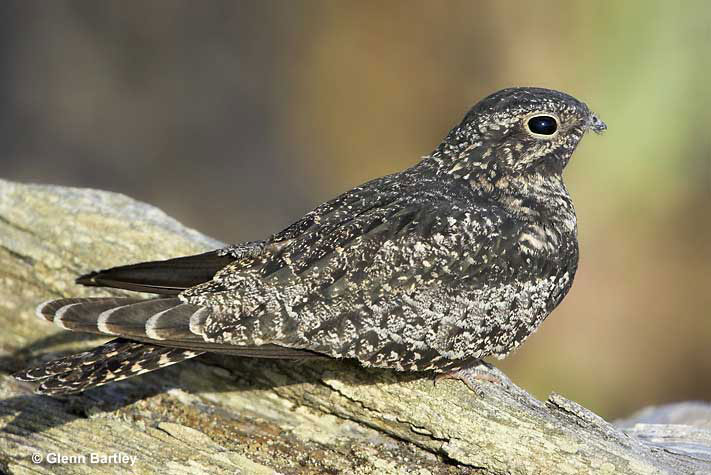
Although Common Nighthawks have white on their throats, it’s much more extensive than the Eastern Whip-poor-will. They have white patches near the tips of their wings and a forked tail. Common Nighthawks also differ by flying high in the air instead of sallying for insects from a low perch.
Common Pauraque
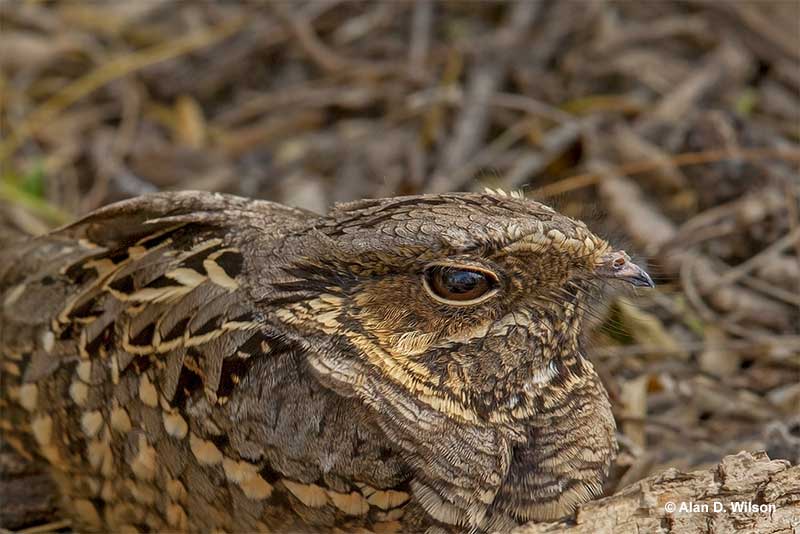
In the USA, Common Pauraques only live in southern Texas. However, Eastern Whip-poor-wills do winter in that area and could be confused with them. Fortunately, the Common Pauraque is easily separated by the white patches in its wings, buff edging on its shoulders, and more white in its long tail.
Frequently Asked Questions
Are Eastern Whip-poor-wills rare?
No, Eastern Whip-poor-wills are not rare. However, they have become uncommon in some areas and their nocturnal behavior can make them tough to see.
What does the Eastern Whip-poor-will symbolize?
The Eastern Whip-poor-will symbolizes hope and resilience, messages from the spiritual realm, and the culture of the Appalachian region.
Is the Whip-poor-will nocturnal?
Yes, the Whip-poor-will is nocturnal. This nightjar species is only active at night.
Is a nighthawk the same as a Whip-poor-will?
No, a nighthawk is not the same as a Whip-poor-will. Although they belong to the same bird family (the Nightjars), nighthawks have more pointed wings, spend the night flying over fields and woods, and have very different vocalizations.

